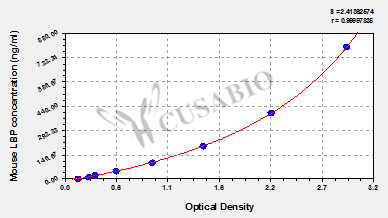Lipopolysaccharide-binding protein (LBP) is an acute-phase protein that functions in the innate immune response to bacterial infections. This glycoprotein binds to lipopolysaccharide from gram-negative bacteria and transfers it to CD14 and Toll-like receptor 4, which initiates inflammatory cascades. LBP levels rise significantly during sepsis and other inflammatory conditions. This makes it a valuable biomarker for monitoring immune activation and bacterial infection severity in research applications.
The Mouse Lipopolysaccharide-binding protein ELISA kit (CSB-EL012775MO) uses a quantitative sandwich measurement principle for detecting LBP in Mus musculus samples. This assay works with serum, plasma, and tissue homogenates with a detection range of 12.5 ng/mL to 800 ng/mL and sensitivity of 3.12 ng/mL. The protocol requires 50-100 μL sample volume and takes 1-5 hours to complete, with detection performed at 450 nm wavelength.
Application Examples
Note: The following application examples are drawn from a selection of publications citing this product. For additional applications, please refer to the full list of references in the "Citations" section.
This ELISA kit has been used in research studies to measure lipopolysaccharide-binding protein levels in plasma samples from mouse models. Applications include inflammatory response research and studies examining how various interventions affect systemic biomarkers.
• Inflammatory biomarker profiling - Measurement of lipopolysaccharide-binding protein alongside other inflammatory markers including cytokines in plasma samples to assess systemic inflammatory responses
• Endocrine and metabolic research - Analysis of lipopolysaccharide-binding protein levels in studies investigating hormonal parameters and metabolic function in mouse models
• Intervention studies - Quantification of plasma lipopolysaccharide-binding protein to evaluate how experimental treatments or exposures affect inflammatory biomarker profiles






